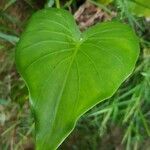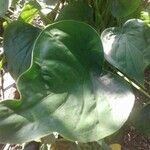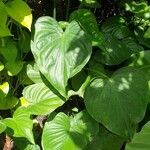Herbs, clumping, small to medium sized, somewhat robust, to 1 m, evergreen. Stems erect, hypogeal, basally much branched. Leaves many together; petiole weakly D-shaped in cross section, 25-30(-80) cm, sheath reaching to ca. 1/2 way, margins membranous; leaf blade broadly ovate-cordate, 10-40 × 7-28 cm, base shallowly cordate, apex acute; primary veins 4 on each side, radiating from petiole, arching, interprimary veins not forming a collective vein. Inflorescences rarely produced, usually solitary, sometimes paired, among leaf bases, subtended by membranous cataphylls; peduncle 20-30 cm. Spathe green, 9-15 cm; proximal spathe 4-8 × ca. 2.5 cm; limb narrowly cymbiform, 5-10 × 3-5 cm. Spadix 8-14 cm; female zone cylindric, 1.5-2.5 cm × ca. 7 mm; sterile zone 2-3 cm × ca. 3 mm; male zone yellow, ca. 3.4 cm × 8 mm; appendix yellowish, narrowly conic, ca. 3.5 cm × 5 mm. Fruit rarely produced, a subglobose berry, 6-8 mm in diam., ripening red. Fl. May.
More
A herb. It is a plant with a tuber and it keeps growing from year to year. It can grow for only one year. It grows to 1.5 m high. The stem can be 50 cm long and 5 cm wide. The leaf stalk is 1 m long. The leaf stalk joins the leaf blade at the edge. The leaf is glossy and oval to heart shaped. It only has short lobes at the base. It is green. The leaf blade is 40 cm long by 28 cm wide. It forms suckers freely. The flowers have a spathe 9-15 cm long.



